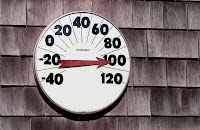With temperatures reaching triple digits the past few weeks, it’s a good time to review the signs and symptoms of heat stroke verses heat exhaustion.
Symptoms of Heat Exhaustion
 Profuse sweating
Profuse sweating- Water depletion (causes extreme thirst)
- Weakness
- Dizziness
- Salt depletion (causes muscle cramps)
- Nausea
- Vomiting
- Fainting
- Headache
Heat Stroke Symptoms
- Body temperature greater than 104° F (main sign)
- No sweating in hot weather
- Neurological problems such as confusion, unconsciousness, and seizures
- Rapid breathing
- Increased heart rate
Risk Factors
- Hot, humid weather is the main contributing factor of heat stroke.
- Children younger than four years old and adults age 65 and older are at risk because their bodies are unable to regulate temperature.
- However, everyone is susceptible to heat stroke.
Treatment
If someone is the victim of heat stroke, it is advisable to call emergency services for help, as heat stroke can be fatal if not treated. While waiting, people can care for the victim until help arrives by putting the person in an ice bath or placing bags of ice on the neck, armpits and groin, where many blood vessels are collected.
It is advised to take the victim into shade and give them proper forms of hydration like water or hydrating sports drinks. If someone is suffering from heat exhaustion, they can recover by moving to cool environments and hydrating.
Prevention
Heat stroke is preventable. Here are some tips to stay healthy in the heat:
- Stay hydrated (non-alcoholic and non-caffeinated beverages).
- Know the day’s forecast (heat index and humidity).
- Plan around the heat; try doing outdoor activities earlier in the morning or later in the evening.
- Wearing less clothing while doing outdoor activities may seem like a good idea to stay cool, but with that comes the risk of sunburn, another factor in heat stroke. Sun-damaged skin is not able to go through the process of keeping the body cool.
For More Information
When it comes to extreme temperatures, play it safe. Know the warning signs of heat stroke, and take the proper steps to prevent it. For more information, please call one of our OSF PromptCare locations.
Last Updated: February 9, 2022